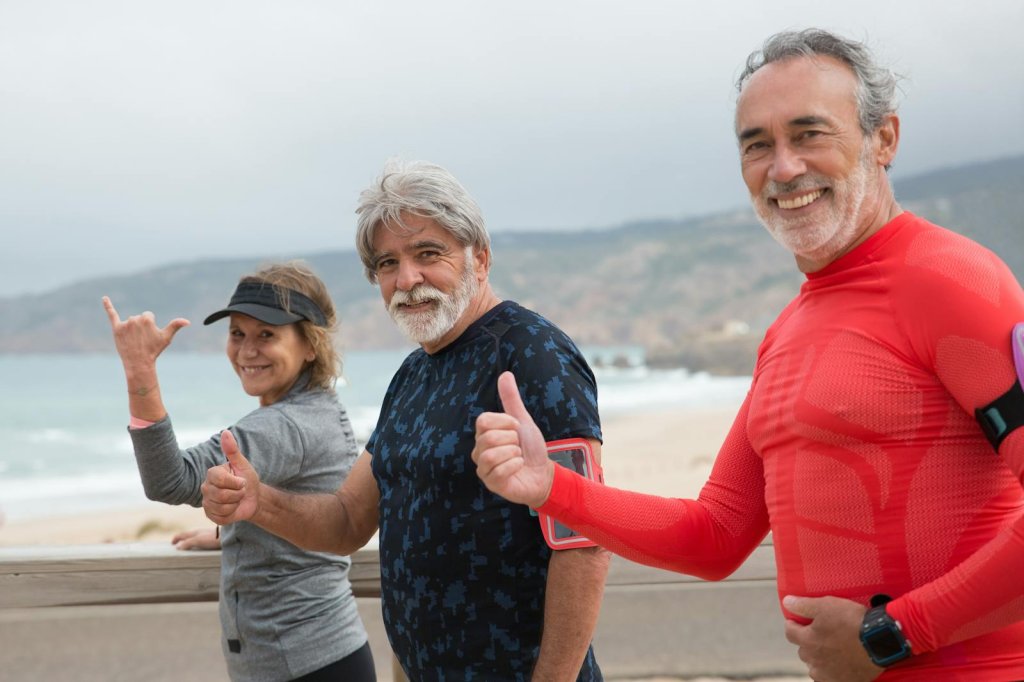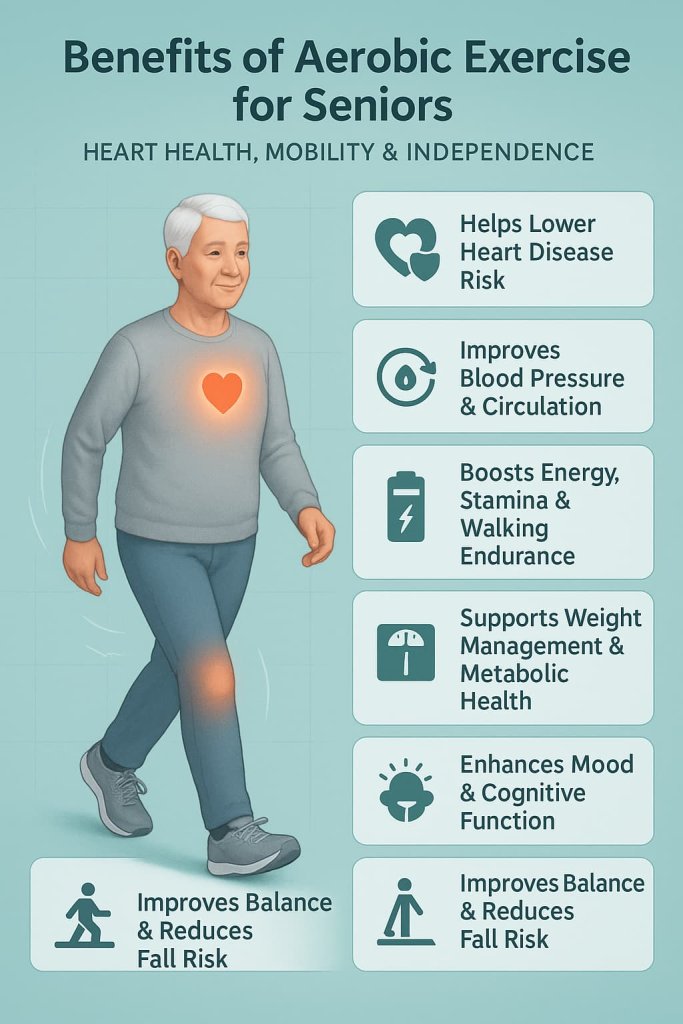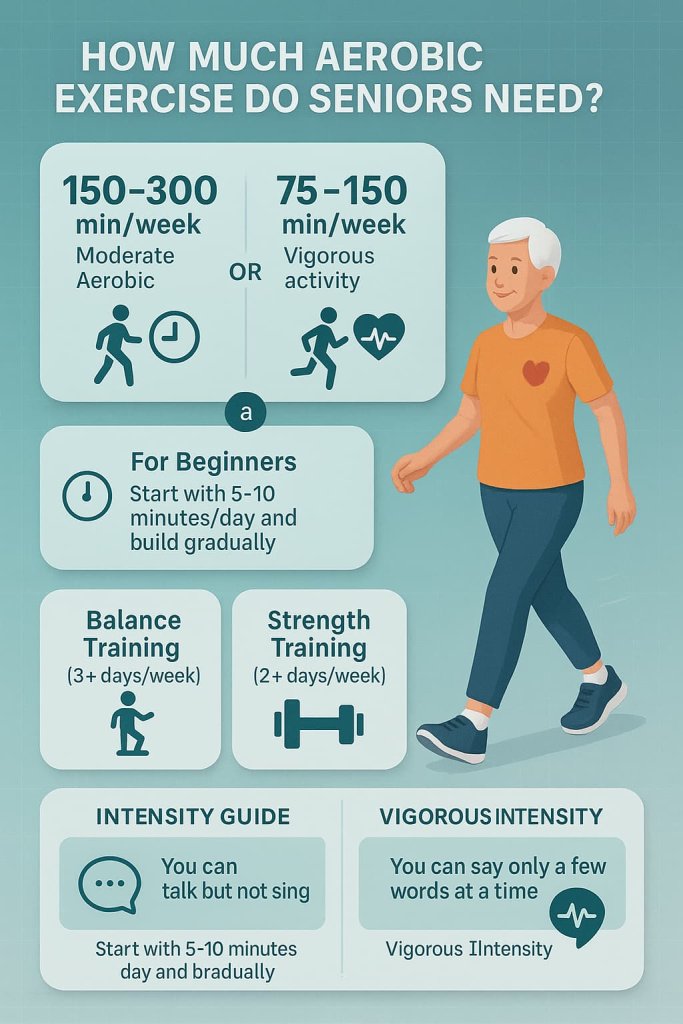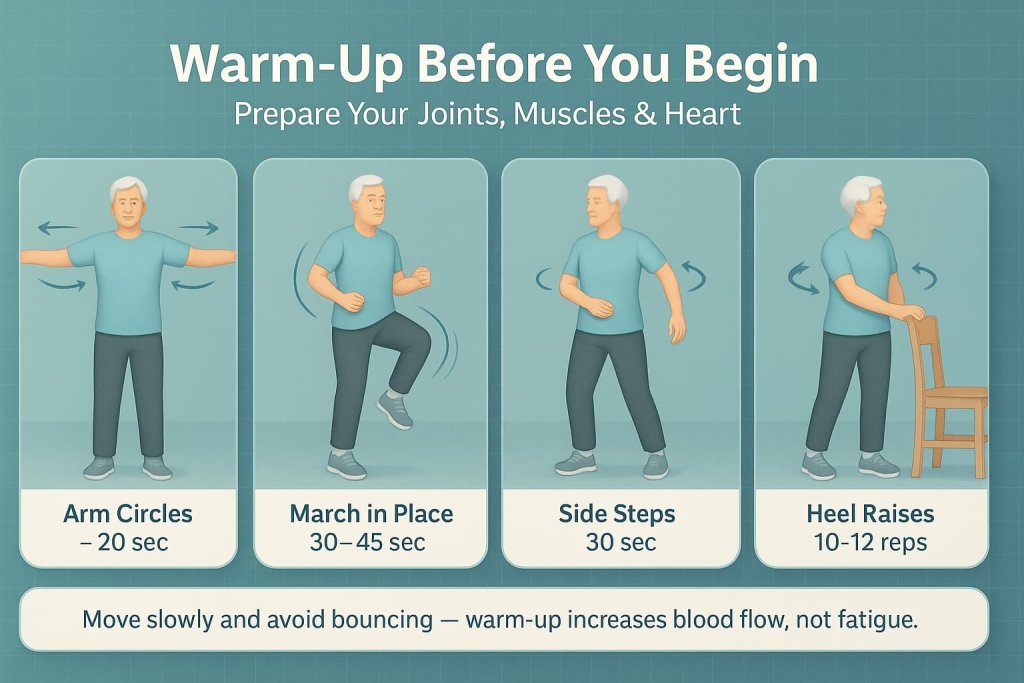Aerobic exercise for seniors is one of the safest and most effective ways to improve heart health, energy, balance, and mobility. Even 10–15 minutes a day can make a meaningful difference. Current guidelines recommend at least 150 minutes of moderate aerobic activity per week for adults over 60 (CDC & WHO).

Understanding the right exercises helps seniors stay active with confidence. This guide covers the 12 best low-impact aerobic movements, how to do them safely, and how often to train—based on the latest evidence and official recommendations.
Benefits of Aerobic Exercise for Seniors
Aerobic exercise supports healthy aging because it:
- Helps lower the risk of heart disease.
- Improves blood pressure and circulation

- Boosts energy, stamina, and walking endurance
- Supports weight management and metabolic health
- Enhances mood and cognitive function
- Improves balance and reduces fall risk when combined with strength and mobility training
- Helps maintain independence with daily activities
- Supports joint health through safe, low-impact movement
How Much Aerobic Exercise Do Seniors Need?

Most seniors should aim for:
- 150–300 minutes/week of moderate aerobic activity
- OR 75–150 minutes/week of vigorous activity
- OR a combined mix of both
- Beginners: Start with 5–10 minutes/day, increasing gradually
- Include balance and strength training alongside cardio for best results
Moderate intensity: You can talk but not sing.
Vigorous intensity: You can say only a few words at a time.
Warm-Up Before You Begin
A gentle warm-up prepares the joints, improves circulation, and reduces strain.

Quick Warm-Up (3–5 Minutes):
- Arm circles – 20 seconds
- March in place – 30–45 seconds
- Slow side steps – 30 seconds
- Gentle torso rotations – 10 each way
- Heel raises – 10–12 reps
Move slowly and avoid bouncing. The goal is to increase blood flow, not fatigue yourself.
12 Best Aerobic Exercises for Seniors
Below are the most effective, low-impact, senior-friendly aerobic exercises. Each includes simple instructions and key benefits.
1. Brisk Walking
Why it works:
Brisk walking elevates heart rate safely while keeping impact low, making it ideal for older adults. It supports cardiovascular health, improves circulation, and enhances balance mechanics used in daily life—like stepping, turning, and stabilizing on uneven surfaces.
Muscles worked:
- Quadriceps
- Hamstrings
- Glutes
- Calves
- Core stabilizers
- Hip flexors
How to do it:
- Walk at a pace where you can still talk but feel gently challenged.
- Maintain upright posture with relaxed shoulders.
- Start with 10–20 minutes, 3–5 days per week.
- Add 2–5 minutes each week as endurance improves.
- Use a treadmill set to 0–1% incline if walking indoors.
Trainer Tip:
Take shorter, quicker steps instead of long strides—this reduces joint impact and improves balance stability.
2. Marching in Place
Why it works:
Marching in place raises the heart rate without requiring space, equipment, or balance challenges. It improves hip mobility, circulation, and gait rhythm—all essential for daily walking confidence.
Muscles worked:
- Hip flexors
- Quadriceps
- Core stabilizers
- Shoulders and arms (with arm swing)
How to do it:
- Stand tall and lift one knee toward hip height.
- Lower it and lift the opposite knee.
- Swing arms naturally to increase heart rate.
- March for 1–3 minutes, rest, and repeat for 2–3 rounds.
Trainer Tip:
Hold onto a counter or chair if you need extra balance support while still keeping the movement aerobic.
3. Stationary Cycling
Why it works:
Cycling provides smooth, controlled motion with minimal joint stress. A recumbent bike adds back support, making this a safe option for seniors with knee or lower-back sensitivities.
Muscles worked:
- Quadriceps
- Hamstrings
- Glutes
- Calves
How to do it:
- Set the bike to light resistance.
- Maintain steady, smooth pedaling.
- Ride for 10–20 minutes, gradually increasing duration as fitness improves.
Trainer Tip:
Keep knees aligned with toes and avoid rocking side to side—this protects hips and knees during the ride.
4. Water Aerobics
Why it works:
Water reduces joint impact by up to 75%, making aerobic movements comfortable even for those with arthritis. The water’s resistance improves strength, mobility, and heart health without overloading joints.
Muscles worked:
- Shoulders
- Core
- Glutes
- Quads and hamstrings
- Upper back
How to do it:
- Stand in waist-deep water.
- Perform water walking, gentle marches, or light arm movements.
- Continue for 20–30 minutes at a comfortable pace.
Trainer Tip:
Move through the water with open hands for more resistance—great for strengthening without added weights.
5. Low-Impact Dancing
Why it works:
Low-impact dance combines coordination, balance, rhythm, and cardiovascular movement. It supports cognitive function, reaction time, and memory—important benefits for healthy aging.
Muscles worked:
- Glutes
- Quadriceps
- Calves
- Core
- Shoulders (with arm movements)
How to do it:
- Choose slow to moderate music.
- Follow beginner-friendly steps or a simple routine.
- Continue for 10–20 minutes at a steady pace.
Trainer Tip:
Dance near a stable surface if balance varies. Keeping steps small reduces joint stress.
6. Step-Ups (Using a Low Step or Stair)
Why it works:
Step-ups mimic daily movements like climbing stairs and stepping onto curbs. This improves functional leg strength, gait mechanics, and balance while providing aerobic benefits.
Muscles worked:
- Glutes
- Quadriceps
- Hamstrings
- Calves
How to do it:
- Step up with one foot, then bring the other foot up.
- Step down with control.
- Continue for 1–3 minutes, switching your lead foot halfway.
Trainer Tip:
Use a low step (4–6 inches) to keep knee stress minimal and confidence high.
7. Elliptical Trainer
Why it works:
The elliptical offers a smooth gliding motion that is easy on the knees, hips, and lower back. It engages upper and lower body muscles simultaneously for an effective aerobic workout.
Muscles worked:
- Glutes
- Quadriceps
- Hamstrings
- Calves
- Arms and shoulders (if using handles)
- Core
How to do it:
- Set resistance to the lowest level.
- Maintain slow, controlled gliding steps.
- Begin with 5–10 minutes, adding time gradually.
Trainer Tip:
Keep your posture upright and avoid leaning heavily on the handles—this improves balance and core activation.
8. Chair Aerobics
Why it works:
Chair aerobics allow seniors with mobility or balance challenges to safely raise their heart rate. It encourages full-body movement without the risk of falls.
Muscles worked:
- Hip flexors
- Shoulders
- Core
- Glutes
- Lower legs
How to do it:
- Sit upright in a sturdy chair.
- Perform seated marching, arm reaches, and toe taps.
- Work in 1–2 minute intervals, resting as needed.
Trainer Tip:
Choose a chair without wheels for stability and keep movements controlled rather than fast.
9. Outdoor Cycling
Why it works:
Outdoor cycling enhances aerobic capacity while training balance, visual coordination, and reaction time. It’s ideal for active seniors who enjoy outdoor movement.
Muscles worked:
- Quadriceps
- Hamstrings
- Glutes
- Calves
How to do it:
- Ride on flat, smooth bicycle paths.
- Wear a helmet at all times.
- Start with 10–15 minutes, gradually increasing duration.
Trainer Tip:
Choose early morning or late afternoon rides to avoid heat and ensure safer visibility.
10. Light Aerobic Circuits
Why it works:
Circuits keep the heart rate elevated through variety, which helps prevent boredom. Mixing movements like marching, side steps, and mini squats improves coordination and cardiovascular fitness.
Muscles worked:
- Full body
- Legs, core, and shoulders (primarily)
How to do it:
Perform each movement for 30–45 seconds:
- Marching
- Side steps
- Mini squats (with support)
- Arm reaches
Rest for 30 seconds and repeat 2–3 rounds.
Trainer Tip:
Move at a pace where you can still talk comfortably to keep intensity safe.
11. Swimming (Laps or Water Walking)
Why it works:
Swimming and water walking support the entire body while minimizing joint impact. Water resistance strengthens muscles gently, while the buoyancy reduces load on the spine and knees.
Muscles worked:
- Back
- Shoulders
- Core
- Glutes
- Legs
How to do it:
- Swim 1–2 easy laps, resting as needed.
- Or water-walk for 5–10 minutes in chest-deep water.
Trainer Tip:
Use a flotation belt or kickboard for extra support if endurance or swimming technique is limited.
12. Stair Climbing
Why it works:
Stair climbing blends aerobic training with leg strengthening. It improves cardiovascular capacity, leg power, and daily functional ability such as climbing household stairs.
Muscles worked:
- Quadriceps
- Glutes
- Hamstrings
- Calves
How to do it:
- Hold a handrail for support.
- Climb 1–2 flights at an easy pace.
- Rest and repeat for 2–3 rounds.
Trainer Tip:
Step whole-foot onto each stair to reduce stress on the knees and improve stability.
How to Progress Safely Each Week
Gradual progression helps seniors improve fitness without overexertion.
Ways to progress:
- Add 2–5 minutes weekly to your main activity
- Slightly increase pace while maintaining good form
- Add light intervals (30 seconds faster, 30 seconds slower)
- Incorporate new exercises every 1–2 weeks
- Improve posture and step technique as comfort grows
Avoid jumping intensity too quickly, especially if you’re new to exercise.
Safety Tips Before Seniors Begin
- Warm up 3–5 minutes (easy walking, arm circles)
- Wear supportive shoes
- Keep movements slow and controlled
- Use support (wall, chair, handrail) when needed
- Stay hydrated
- Stop exercising and consult a clinician if you experience dizziness, chest pain, or unusual shortness of breath
- If you have chronic conditions, ask your provider about a safe intensity range
Who Should Avoid Certain Aerobic Exercises?
Some seniors should use caution or consult a clinician before increasing intensity, especially if they have:
- Unstable heart or lung conditions
- Severe joint pain or arthritis flare-ups
- Frequent dizziness or balance loss
- Recent surgery or orthopedic injuries
- Uncontrolled blood pressure
- Shortness of breath at rest
For these individuals, chair-based, water-based, or supervised exercise programs may be better starting points.
Weekly Aerobic Exercise Plan for Seniors
Use this simple weekly starter schedule:
| Day | Activity |
|---|---|
| Mon | 20 min walking + 5 min balance training |
| Tue | 10 min step-ups + 10 min chair aerobics |
| Wed | Rest or light stretching |
| Thu | 15–20 min stationary cycling |
| Fri | 20 min low-impact dance |
| Sat | 15 min brisk walking |
| Sun | Optional 10 min water aerobics |
Common Questions Seniors Ask (FAQ)
1. What is the safest aerobic exercise for seniors?
Walking, cycling, and water aerobics are considered among the safest due to low joint impact.
2. Is walking enough aerobic exercise for seniors?
Yes. Walking can fully meet the CDC’s 150-minute weekly aerobic target.
3. How long should a senior do aerobic exercise daily?
Start with 10–20 minutes and increase gradually.
4. Can seniors exercise with arthritis?
Low-impact options like water aerobics, cycling, and walking are generally recommended. Check with a clinician if symptoms worsen.
5. Should seniors do aerobic exercise every day?
Light to moderate aerobic exercise can be performed daily if tolerated.
6. Can seniors who haven’t exercised in years start now?
Yes—start slow (5–10 minutes) and progress gradually.
7. What intensity is best for seniors?
Moderate intensity (talking but not singing) is ideal for most older adults.
Conclusion
Aerobic exercise is one of the most effective ways for seniors to protect heart health, maintain independence, and improve daily energy. With safe, low-impact options like walking, cycling, dancing, and water aerobics, older adults can stay active at any fitness level. Start slow, stay consistent, and choose movements that feel comfortable and enjoyable.
Ready to build a healthy routine? Start with just 10 minutes today.
References
- Bull FC et al. (2020). WHO 2020 Guidelines on Physical Activity and Sedentary Behaviour.
Global guideline outlining 150–300 min/week moderate or 75–150 min/week vigorous aerobic activity for adults, including older adults.
https://pubmed.ncbi.nlm.nih.gov/33239350/ - CDC (2023). Physical Activity Guidelines for Older Adults.
Clear, practical guidance on how adults 65+ should meet aerobic, strength, and balance recommendations.
https://www.cdc.gov/physical-activity-basics/guidelines/older-adults.html - American College of Sports Medicine (ACSM) Position Stand – Exercise and Physical Activity for Older Adults.
Foundational position stand summarizing how aerobic and resistance exercise support healthy aging, independence, and function.
https://journals.lww.com/acsm-msse/Fulltext/2009/07000/Exercise_and_Physical_Activity_for_Older_Adults.20.aspx - Zhang B et al. (2025). Impact of Aerobic Exercise on Health Management in Older Patients with Hypertension.
Shows that 120–150 minutes/week of low–moderate intensity aerobic exercise improves blood pressure and heart-rate control in older adults with hypertension.
https://pmc.ncbi.nlm.nih.gov/articles/PMC12145098/ - Guo L et al. (2025). Effect of Exercise on Cardiovascular Disease Risk Factors in Sedentary Adults.
Meta-analysis demonstrating that aerobic exercise improves blood pressure, resting heart rate, and other cardiovascular risk factors.
https://www.frontiersin.org/articles/10.3389/fpubh.2025.1470947/full - Xu L et al. (2023). Effects of Exercise on Cognitive Function in Older Adults.
Review showing that aerobic and resistance training significantly improve global cognition and executive function in older adults.
https://pubmed.ncbi.nlm.nih.gov/36673844/
